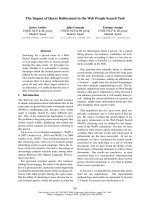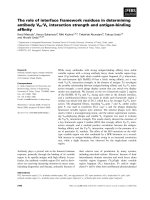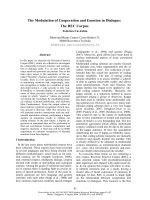Báo cáo khoa học: "The staging of sepsis: understanding heterogeneity in treatment efficacy" ppt
Bạn đang xem bản rút gọn của tài liệu. Xem và tải ngay bản đầy đủ của tài liệu tại đây (41.9 KB, 3 trang )
626
APACHE = Acute Physiology, Age, and Chronic Health Evaluation; rhAPC = recombinant human activated protein C.
Critical Care December 2005 Vol 9 No 6 Marshall
Abstract
Human sepsis is an intrinsically complex disease. Populations of
patients enrolled into clinical trials of novel sepsis therapies are
notoriously heterogeneous with respect to the inciting cause of their
disease, the co-morbid conditions that define its course, and the
acute severity of their initial presentation. This heterogeneity is
reflected in strikingly variable mortality risks across studies, and
probably, though less clearly-established, in variable response rates
to a given intervention. In an accompanying article in this issue of
Critical Care, Macias and colleagues argue that the effectiveness of
adjuvant sepsis therapies is not dependent on the baseline mortality
risk, since the few “positive” trials that have been published show
widely divergent placebo mortality rates. But this analysis assumes
that biologically distinct interventions will be equally efficacious in
clinically diverse populations, and confuses severity as a population
descriptor with severity as a surrogate measure of a biologic state in
an individual patient. In a pivotal trial of recombinant human
activated protein C (rhAPC) in patients with severe sepsis, an
aggregate 6% mortality decrement appeared to be the result of
negligible efficacy in the least severely ill patients, and considerably
greater efficacy in those who were at greatest risk of dying. A larger
follow-up study recruiting low risk patients confirmed this
impression, showing a convincing absence of benefit in patients
who clinicians judged to be less severely ill. If we accept Macias’
argument, we are led to the conclusion that rhAPC is of limited use
in the management of severe sepsis. On the other hand, if we view
severity as a crude surrogate for a particular pathologic state, we
would shift our focus to better defining those populations most likely
to benefit from intervention, including patients who may not have
met criteria for entry in the original PROWESS trial – those with
disseminated intravascular coagulation or acute organ dysfunction
from causes other than sepsis. Staging systems that stratify
heterogeneous patient populations by risk and by potential to
benefit from intervention have proven to be essential to the
development of multimodal adjuvant treatment for cancer. They will
be no less important in the optimal management of sepsis.
To the casual observer, the patients who inhabit a contemporary
intensive care unit must present a single and frightening image.
All are dressed in the same custom issue intensive care unit
garb, and all are confined to bed - the passive recipients of a
bewildering array of life support technologies. Each has a
variable number of plastic tubes emanating from a number of
orifices, both anatomic and iatrogenic, and through these tubes
is receiving unknown fluids, or expelling those that are only too
familiar. Most are on mechanical ventilators, and beds that are
capable of quite remarkable contortions. Some are undergoing
dialysis, while others seem to be making an agonizing effort to
return to a state of coherence and autonomy. But it is their
similarities, rather than their differences, that create the most
enduring impression.
To the intensivist caring for these patients, however, the picture
is much more complex. The course of this otherwise well young
woman struggling to survive the consequences of a pregnancy
complicated by a placental abruption and disseminated
intravascular coagulation may be rendered more complicated by
a ventilator-associated pneumonia. But for the elderly man in the
next bed, who lacking family or friends to make a decision in the
final days of his life was admitted with a further exacerbation of
chronic lung disease, the same pneumonia holds the elusive
possibility of a dignified death. Across the way is a middle-aged
man with an anastomotic leak following an esophagectomy who
has now developed acute renal failure, and an elderly woman
admitted last night with shock, and a poorly characterized
infiltrate on the chest X-ray. For each of these individuals,
sustaining life is a relatively simple matter of identifying the
physiological insult or insults that comprises an immediate
threat, and initiating the appropriate means of exogenous
support, be it mechanical ventilation, dialysis, or vasoactive
medications. The much greater, and largely unsolved, challenge
is to understand the pathological processes that are responsible
for potentially lethal organ dysfunction, so that specific
treatments that target these might be given.
Commentary
The staging of sepsis: understanding heterogeneity in treatment
efficacy
John C Marshall
Professor of Surgery, Departments of Surgery and Critical Care Medicine, University of Toronto, Toronto, Ontario, Canada
Corresponding author: John C Marshall,
Published online: 22 November 2005 Critical Care 2005, 9:626-628 (DOI 10.1186/cc3907)
This article is online at />© 2005 BioMed Central Ltd
See related research by Macias et al. in this issue [ />627
Available online />Sepsis, a syndrome characterized by a dysregulated and
destructive response to infection, is a theme common to each
of the hypothetical patients above, and to many of the most
complex patients cared for in the contemporary intensive care
units. A variety of strategies, both proven and potential, have
emerged to manage this state: the challenge for the
intensivist is understanding when, how, and in whom to use
them. This challenge is amplified by the enormous
heterogeneity of the patient population, and has spurred
attempts to develop stratification models that can resolve this
heterogeneity [1-3]. Foremost among these is the still largely
theoretical PIRO model that proposes stratifying patients on
the basis of measures of ‘predisposition’, the nature of the
acute ‘insult’, the nature of the host ‘response’, and the
baseline degree of ‘organ dysfunction’ [3].
Macias and colleagues [4] in this issue of Critical Care report
the results of one such analysis. Synthesis of the results of a
heterogeneous group of pre-clinical studies in animal models
suggested the hypothesis that the response to intervention
with strategies that target the innate host inflammatory
response is dependent on the severity of the inciting insult,
reflected in the mortality rate of the placebo population [5].
Macias et al. [4] undertook a systematic review of 22 phase
III studies of 17 different therapeutic strategies for sepsis,
and concluded that there is no evidence of an interaction
between baseline mortality risk and the potential to benefit
from treatment. While they are to be applauded for
undertaking this analysis, in my view, both the question they
ask, and the conclusions they draw, miss the mark.
The authors’ conclusion that baseline mortality risk does not
impact the potential for benefit or harm derives primarily from
the observation that the three clinical trials showing a
statistically significant beneficial treatment effect have
placebo mortality rates ranging from 31% to 61%, whereas
an apparent lack of efficacy in other trials occurs across a
spectrum of baseline mortality risk. There are several
important flaws in this analysis. First, it proceeds from the
simplistic assumption that agents that target highly diverse
aspects of a complex disease process will be equally
efficacious in all patients with sepsis. But this is clearly not
the case. Vasoactive medications, for example, are only of
use in the septic patient with refractory hypotension, and
mechanical ventilation does not help the patient without
respiratory insufficiency; indeed, intervention in the absence
of a clearly established need may generate harm. Similarly,
treatment with recombinant human activated protein C
(rhAPC) improves survival in patients who are more severely
ill, as measured by Acute Physiology, Age, and Chronic
Health Evaluation (APACHE) II score or the number of failing
organs [6], a conclusion suggested by a subgroup analysis of
the pivotal PROWESS study and confirmed in a recently
published and much larger multicenter trial [7]. On the other
hand, intervention with anti-tumor necrosis factor therapy
appears to be of benefit primarily in patients without
established organ dysfunction [8], while the detrimental
effects of blood transfusion are most apparent in patients
with lower severity of illness [9]. Pooling data from a
biologically disparate group of studies serves to obscure,
rather than to illuminate, a treatment-severity interaction.
Moreover, the analysis confuses severity as a population
descriptor with severity as a descriptor of individual patients
within that population. Assuming that the potential to respond
to treatment varies across unknown or undefined
characteristics of patients within a study population, then the
absence of an effect in a trial reflects one of three
possibilities: that the agent is truly lacking in clinical efficacy;
that the absence of activity reflects benefit in some patients,
and harm in others; or that the agent is efficacious, but the
magnitude of that activity is too small to be detected given
the size of the population studied, or that a larger effect is
diluted by the absence of activity in some patients.
Thus, if the agent truly works in the population of interest, an
inappropriate conclusion of no effect may reflect either
concomitant harm or dilution of the true effect by the inclusion of
patients who could not benefit. Harm is a very real concern in
studies of novel therapies for sepsis, whether a consequence of
inappropriate dosing or titration or of unanticipated biological
activity [10,11]. The problem, however, of inappropriately
minimizing efficacy through the inclusion of patients who have
no chance of benefiting is an even greater concern to the
clinician, whose objective is to target the right treatment to the
right patient, and to avoid treating those who have no chance of
benefit. A recent example illustrates this problem (Table 1).
rhAPC (or drotrecogin alpha activated) was approved by
North American and European regulatory agencies for the
treatment of severe sepsis and septic shock on the basis of a
multicenter trial showing a 6.1% absolute mortality reduction
Table 1
Efficacy of drotrecogin alpha activated as a function of
baseline severity of illness in phase III trials
28 Day mortality (%)
APACHE II score Placebo rhAPC Odds ratio 95% CI p
≤24
PROWESS 19.1 18.7
ADDRESS 16.0 16.9
Pooled 16.8 17.4 1.04 0.86-1.26 0.72
>24
PROWESS 43.1 31.5
ADDRESS 24.8 29.4
Pooled 38.0 30.9 0.73 0.57-0.94 0.01
Overall mortality 22.4 21.0 0.92 0.79-1.06 0.26
APACHE, Acute Physiology, Age, and Chronic Health Evaluation; CI,
confidence interval; rhAPC, recombinant human activated protein C.
628
Critical Care December 2005 Vol 9 No 6 Marshall
in patients receiving the agent. Secondary analyses
suggested that the potential to benefit from treatment was not
homogeneous throughout the population, but rather restricted
to patients with greater severity of illness at trial entry, and led
to restrictions on the use of drotrecogin alpha activated and a
requirement that a second trial evaluate efficacy in a lower risk
population. That study, recently published, confirmed the
absence of efficacy in a lower risk population [7]. If we pool
data from the two published phase III trials of rhAPC in sepsis,
treatment increases the probability of survival by 7.1% in the
sickest patients, those with APACHE II scores of 25 or higher.
But now the mortality benefit across the entire population is
only 1.4%, even smaller than that seen in other sepsis trials
[12] and no longer statistically significant. Should rhAPC be
relegated to the ignominious scrap heap of other ‘failed’
sepsis therapies or ‘negative’ sepsis trials? I would argue no.
But it is entirely likely that we will hear this line of argument
with increased vehemence in the wake of the publication of
the ADDRESS trial [7].
The flaw here – and in Macias and colleagues’ line of
reasoning as well – is that populations of patients with
patients with sepsis are intrinsically heterogeneous in both
their baseline risk of adverse outcome and their potential to
respond to intervention. Failing to acknowledge that hetero-
geneity by increasing the relative proportion of patients who
cannot benefit from intervention only serves to mask a
potential treatment effect. Conversely, a more careful targeting
of specific therapeutic strategies to more biologically homo-
geneous groups of patients is essential to developing effective
adjuvant treatment. High dose corticosteroid therapy was
shown to be ineffective or even harmful in patients with severe
sepsis [13,14], whereas pharmacological doses of steroids
improve the survival of patients with refractory septic shock
and relative adrenal insufficiency [15]. Goal-directed hemo-
dynamic management is very efficacious early in the course of
severe sepsis and septic shock [16], but ineffective if delayed
[17]. Anti-tumor necrosis factor therapy has a marginal impact
when given to a heterogeneous population of patients with
sepsis [12,18], but is much more efficacious when given to
patients without significant organ dysfunction at study entry
[8]. In contrast, rhAPC is more effective in patients with
greater degrees of organ dysfunction [6].
The unmet challenge in sepsis research is not the
identification of therapeutic targets, but the development of
sensible, robust, and validated methods of stratifying patients,
analogous to those that currently guide the use of adjuvant
therapy in oncology. Baseline mortality risk or severity of
illness measured by a non-specific physiological scale such
as APACHE is one crude system of stratification. But
mortality risk is a poor surrogate for the complex pathological
processes that define the evolution of sepsis, and more
sophisticated systems must be developed. To fail to do so is
to discard the prospect of biologically rational and clinically
effective therapy for this common and lethal process.
Competing interests
The author(s) declare that they have no competing interests.
References
1. Bone R, Balk R, Cerra F, Dellinger RP, Fein A, Knaus W, Sibbald
W: Definitions for sepsis and organ failure and guidelines for
the use of innovative therapies in sepsis. Chest 1992, 101:
1644-1655.
2. Marshall JC, Vincent J-L, Fink MP, Cook DJ, Rubenfeld G, Foster
D, Faist E, Reinhart K: Measures, markers, and mediators:
Towards a staging system for clinical sepsis. Crit Care Med
2003, 31:1560-1567.
3. Levy MM, Fink M, Marshall JC, Abraham E, Angus D, Cook D,
Cohen J, Opal SM, Vincent J-L, Ramsay G: 2001 SCCM/ESICM/
ACCP/ATS/SIS international sepsis definitions conference.
Crit Care Med 2003, 34:1250-1256.
4. Macias WL, Nelson DR, Williams M, Garg R, Janes J, Sashegyi A:
Lack of evidence for qualitative treatment by disease severity
interactions in clinical studies of severe sepsis. Crit Care
2005, 9:R607-R622.
5. Eichacker PQ, Oarent C, Kalil A, Esposito C, Cui X, Banks SM,
Gerstenberger EP, Fitz Y, Danner RL, Natanson C: Risk and the
efficacy of anti-inflammatory agents: Retrospective and con-
firmatory studies of sepsis. Am J Resp Crit Care Med 2002,
166:1197-1205.
6. Bernard GR, Vincent J-L, Laterre PF, LaRosa SP, Dhainaut J-F,
Lopez-Rodriguez A, Steingrub JS, Garber GE, Helterbrand JD, Ely
EW, et al.: Efficacy and safety of recombinant human activated
protein C for severe sepsis. N Engl J Med 2001, 344:699-709.
7. Abraham E, Laterre PF, Garg R, Levy H, Talwar D, Trzaskoma BL,
Francois B, Guy JS, Bruckmann M, Rea-Neto A, et al.: Drotreco-
gin alfa (activated) for adults with severe sepsis and a low
risk of death. N Engl J Med 2005, 353:1332-1341.
8. Marshall JC, Panacek EA, Teoh L, Barchuk W: Modelling organ
dysfunction as a risk factor, outcome, and measure of bio-
logic effect in sepsis: Results of the MONARCS trial. Crit Care
Med 2001, 28:A46.
9. Hebert PC, Wells G, Blajchman MA, Marshall J, Martin C,
Pagliarello G, Tweeddale M, Schweitzer I, Yetisir E, the Transfu-
sion Requirements in Critical Care Investigators for the Canadian
Critical Care Trials Group: A multicentre randomized controlled
clinical trial of transfusion requirements in critical care. N Engl
J Med 1999, 340:409-417.
10. Fisher CJ Jr, Agosti JM, Opal SM, Lowry SF, Balk RA, Sadoff JC,
Abraham E, Schein RMH, Benjamin E: Treatment of septic
shock with the tumor necrosis factor receptor:Fc fusion
protein. N Engl J Med 1996, 334:1697-1702.
11. Lopez A, Lorente JA, Steingrub J, Bakker J, McLuckie A, Willatts
S, Brockway M, Anzueto A, Holzapfel L, Breen D, et al.: Multiple-
center, randomized, placebo-controlled, double-blind study of
the nitric oxide synthase inhibitor 546C88: effect on survival
in patients with septic shock. Crit Care Med 2004, 32:21-30.
12. Marshall JC: Such stuff as dreams are made on: Mediator-tar-
geted therapy in sepsis. Nature Rev Drug Disc 2003, 2:391-405.
13. Bone RC, Fisher CJ, Clemmer TP, Slotman GJ, Metz CA, Balk RA.
A controlled clinical trial of high dose methylprednisolone in
the treatment of severe sepsis and septic shock. N Engl J
Med 1987, 317:654-658.
14. The Veterans Administration Systemic Sepsis Cooperative Study
Group: Effect of high dose glucocorticoid therapy on mortality
in patients with clinical signs of systemic sepsis. N Engl J Med
1987, 317:659-665.
15. Annane D, Sebille V, Charpentier C, Bollaert P-E, Francois B,
Korach J-M, Capellier G, Cohen Y, Azoulay E, Troche G, et al.:
Effect of treatment with low doses of hydrocortisone and flu-
drocortisone on mortality in patients with septic shock. J Am
Med Assoc 2002, 288:862-871.
16. Rivers E, Nguyen B, Havstad S, Ressler J, Muzzin A, Knoblich B,
Peterson E, Tomlanovich M: Early goal-directed therapy in the
treatment of severe sepsis and septic shock. N Engl J Med
2001, 345:1368-1377.
17. Gattinoni L, Brazzi L, Pelosi P, Latini R, Tognoni G, Pesenti A,
Fumagalli R: A trial of goal-oriented hemodynamic therapy in
critically ill patients. N Engl J Med 1995, 333:1025-1032.
18. Panacek EA, Marshall JC, Albertson TE, Johnson DH, Johnson
SB, MacArthur RD, Miller MA, Barchuk WT, Fischkoff S, Kaul M,
et al.: Efficacy and safety of the monoclonal anti-TNF antibody
F(ab’)
2
fragment afelimomab in patients with severe sepsis
stratified by IL-6 level. Crit Care Med 2004, 32:2173-2182.









